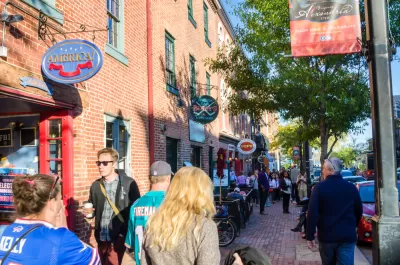When mixed-use development isn’t enough to create vibrant, walkable neighborhoods.

Urbanists make a lot of hay of ‘mixed use,’ writes Erin Caldwell in an op-ed for Next City. Neighborhoods need diverse businesses and services to thrive, urbanists frequently say. But what about the types of businesses?
According to Caldwell, “A neighborhood dense with businesses that do not meet the weekly needs of residents is no better than a neighborhood absent businesses with respect to walkability. Walkability depends, at least in part, on having comprehensive retail.”
For Caldwell, this offers an opportunity for cities to guide development through their zoning codes. “How can cities encourage the presence of businesses that satisfy daily necessities? While zoning based on business type is not new, traditional zoning does not take business usefulness into account. But what if zoning laws allowed useful businesses in residential or mixed-use areas and relegated non-useful businesses to industrial or commercial districts?”
Usefulness is, of course, subjective, so this type of code may be difficult to create and enforce. Caldwell suggests creating objective measures such as the number of in-person transactions or amenities such as public restrooms, bike racks, or public seating. “Besides re-zoning, enrichment through mixed-use can be achieved by permitting business spaces attached to residential units, commonly known as accessory commercial units.”
For Caldwell, retail can have a major impact on community. “Accessible retail and recreation centers are akin to ‘town squares’ in that they provide places and reasons for neighbors to congregate. Repeat visits to businesses increase the likelihood of interaction between neighbors, as well as business staff, who also form an integral part of the community.”
FULL STORY: For Walkable Neighborhoods, We Need More Useful Businesses

Planetizen Federal Action Tracker
A weekly monitor of how Trump’s orders and actions are impacting planners and planning in America.

Congressman Proposes Bill to Rename DC Metro “Trump Train”
The Make Autorail Great Again Act would withhold federal funding to the system until the Washington Metropolitan Area Transit Authority (WMATA), rebrands as the Washington Metropolitan Authority for Greater Access (WMAGA).

DARTSpace Platform Streamlines Dallas TOD Application Process
The Dallas transit agency hopes a shorter permitting timeline will boost transit-oriented development around rail stations.

The Tiny, Adorable $7,000 Car Turning Japan Onto EVs
The single seat Mibot charges from a regular plug in about as much time as an iPad, and is about half the price of an average EV.

Supreme Court Ruling in Pipeline Case Guts Federal Environmental Law
The decision limits the scope of a federal law that mandates extensive environmental impact reviews of energy, infrastructure, and transportation projects.

Texas State Bills to Defund Dallas Transit Die
DART would have seen a 30% service cut, $230M annual losses had the bills survived.
Urban Design for Planners 1: Software Tools
This six-course series explores essential urban design concepts using open source software and equips planners with the tools they need to participate fully in the urban design process.
Planning for Universal Design
Learn the tools for implementing Universal Design in planning regulations.
Roanoke Valley-Alleghany Regional Commission
City of Mt Shasta
City of Camden Redevelopment Agency
City of Astoria
Transportation Research & Education Center (TREC) at Portland State University
US High Speed Rail Association
City of Camden Redevelopment Agency
Municipality of Princeton (NJ)





























